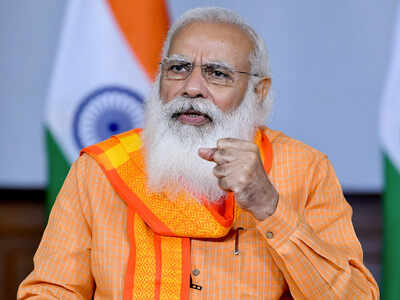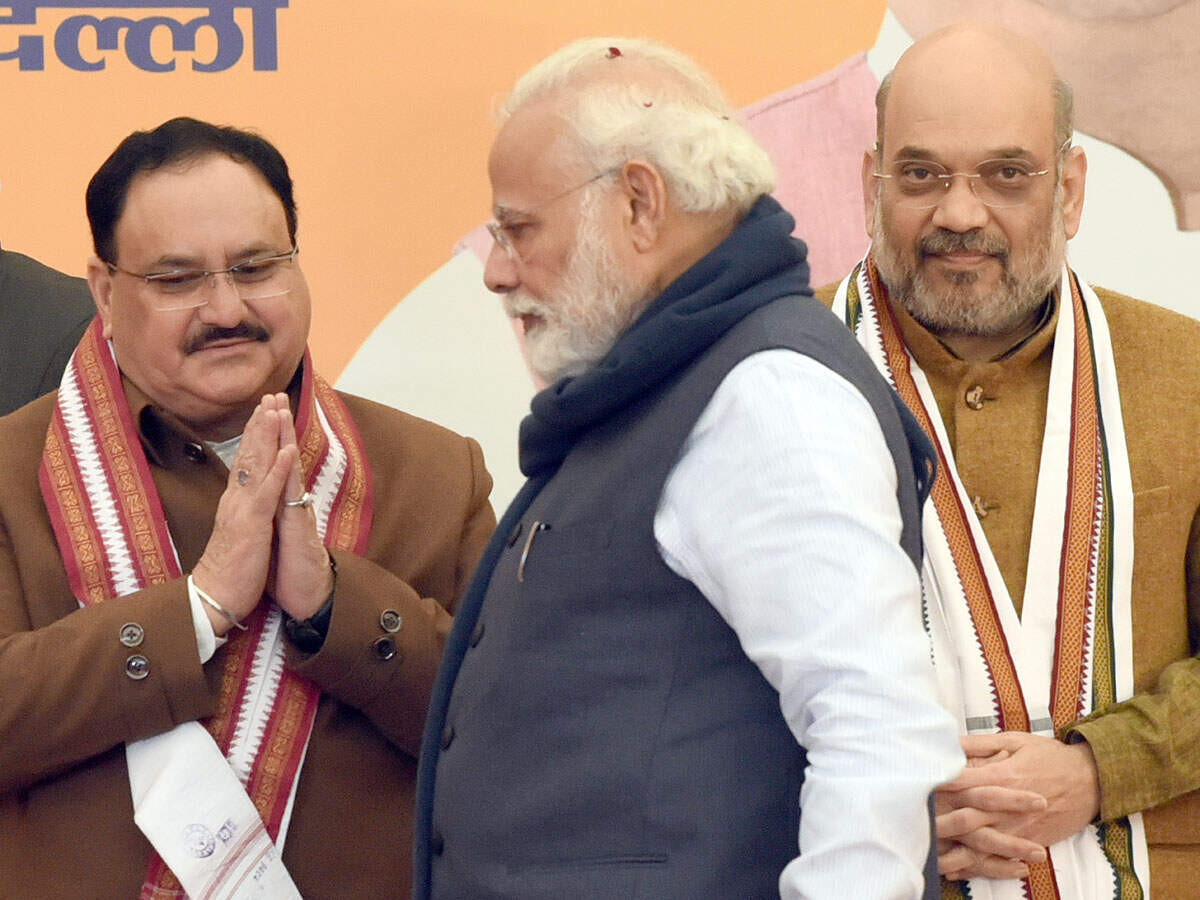Top Searches
- News
- India News
- Modi 2.0: How has BJP fared in assembly elections since its 2019 Lok Sabha triumph
Modi 2.0: How has BJP fared in assembly elections since its 2019 Lok Sabha triumph

PM Modi led the BJP to a historic win in 2019 Lok Sabha elections, but the party has failed to win big in the assembly elections that have followed.
NEW DELHI: After leading BJP to its biggest-ever electoral victory in the Lok Sabha elections — both in terms of seats and vote share — the Narendra Modi-led NDA government assumed office for a consecutive second term on May 26, 2019.
The BJP's strategy of banking on a US presidential-style campaign with PM Modi as its poster boy paid its rich political dividends. The party ended up winning 303 out of the 543 Lok Sabha seats and came across as an unstoppable force.
As the Modi government completes two years of its second term, let's see how did the momentum of Lok Sabha victory hold in the state elections that followed.
The numbers don't quite paint a rosy — or shall we say a saffron — picture for the BJP.
Since the 2019 Lok Sabha polls, 10 states or Union Territories have gone to polls.
Of these, the BJP has managed to win just four assembly elections — that too with the help of its allies.
2019: Double Whammy
Just months after its triumph in the general election, the BJP suffered a double electoral blow when it lost power in both Jharkhand and Maharashtra.
A strong wave of anti-incumbency against the Raghubar Das-led dispensation cost the BJP dearly in Jharkhand.
In Maharashtra, the BJP emerged as the single largest party but failed to retain power as its ally Shiv Sena broke ranks with the NDA and formed the government with the NCP and the Congress.
In Haryana, the party's performance dipped but it managed to form the government after stitching a new post-poll alliance with Dushyant Chautala's Jannayak Janta Party (JPP).
2020: Mixed Bag
The year began with the BJP putting up a dismal show in Delhi, just weeks before the Covid pandemic engulfed the entire country.
The saffron party failed to wrest the national capital from the ruling Aam Aadmi Party and witnessed only a consolation rise in its seat share: from 3 to 8.
But later that year, a close win in Bihar with its ally Nitish Kumar came as a shot in the arm for the saffron party.
The elections — the first major polls to be held amid the Covid pandemic — helped the BJP stamp its authority in the key state where alliances play a big role.
It not only managed to outflank the Tejashwi Yadav-led RJD-Congress combine but also became the senior partner in the Bihar NDA after winning more seats than ally JD(U). However, keeping its pre-poll promise it allowed Nitish Kumar to continue as the chief minister.
2021: Mamata shatters BJP' Bengal dreams

For the BJP, 2021 started on a disappointing political note as Mamata Banerjee led her party Trinamool Congress to a historic win in West Bengal.
A raging pandemic notwithstanding, the BJP and the TMC fought tooth and nail to win the high-stakes battle in West Bengal.
In the end, even a massive gain of 74 seats could not make up for the BJP's failure to topple the Trinamool in Bengal.
Despite investing a great deal of time and political resources in Bengal, the BJP failed to secure even half of the 200 seats it had claimed to win in the run up to the elections.
The saving grace, for the BJP came in the form of twin victories in Assam and Puducherry.
In Assam, the BJP did well to hold on to power despite the anti-incumbency factor and the loss of allies. In Puducherry, the BJP-AINRC alliance helped thwart the Congress-DMK challenge to form the new government.
Down south, the BJP managed to win 4 seats in Tamil Nadu but its alliance with AIADMK lost out to the DMK-Congress combine.
In Kerala, the party was reduced to zero as it failed to hold on to its only seat.
Lok Sabha vs Assembly elections: A worrying trend?
Aside from a string of defeats post-2019, the BJP is staring at a trend that is a cause for worry as it heads into future electoral battles.
In all the assembly polls since Modi government 2.0 took power, the BJP has witnessed a dip in its vote share compared to what it had got in the 2019 Lok Sabha elections.
Take the recently concluded West Bengal polls. The party failed to consolidate the massive gains it made in the Lok Sabha elections and witnessed a dip of 2.12 percentage points.
The trend indicates that the party has failed to replicate its national performance in some of the assembly elections.
It also points to the fact that excessive dependence on Narendra Modi hasn't always worked well for the party, especially in states with strong regional leaders.
The BJP's strategy of banking on a US presidential-style campaign with PM Modi as its poster boy paid its rich political dividends. The party ended up winning 303 out of the 543 Lok Sabha seats and came across as an unstoppable force.
As the Modi government completes two years of its second term, let's see how did the momentum of Lok Sabha victory hold in the state elections that followed.
The numbers don't quite paint a rosy — or shall we say a saffron — picture for the BJP.
Since the 2019 Lok Sabha polls, 10 states or Union Territories have gone to polls.
Of these, the BJP has managed to win just four assembly elections — that too with the help of its allies.
2019: Double Whammy
Just months after its triumph in the general election, the BJP suffered a double electoral blow when it lost power in both Jharkhand and Maharashtra.
A strong wave of anti-incumbency against the Raghubar Das-led dispensation cost the BJP dearly in Jharkhand.
In Maharashtra, the BJP emerged as the single largest party but failed to retain power as its ally Shiv Sena broke ranks with the NDA and formed the government with the NCP and the Congress.
In Haryana, the party's performance dipped but it managed to form the government after stitching a new post-poll alliance with Dushyant Chautala's Jannayak Janta Party (JPP).
2020: Mixed Bag
The year began with the BJP putting up a dismal show in Delhi, just weeks before the Covid pandemic engulfed the entire country.
The saffron party failed to wrest the national capital from the ruling Aam Aadmi Party and witnessed only a consolation rise in its seat share: from 3 to 8.
But later that year, a close win in Bihar with its ally Nitish Kumar came as a shot in the arm for the saffron party.
The elections — the first major polls to be held amid the Covid pandemic — helped the BJP stamp its authority in the key state where alliances play a big role.
It not only managed to outflank the Tejashwi Yadav-led RJD-Congress combine but also became the senior partner in the Bihar NDA after winning more seats than ally JD(U). However, keeping its pre-poll promise it allowed Nitish Kumar to continue as the chief minister.
2021: Mamata shatters BJP' Bengal dreams

For the BJP, 2021 started on a disappointing political note as Mamata Banerjee led her party Trinamool Congress to a historic win in West Bengal.
A raging pandemic notwithstanding, the BJP and the TMC fought tooth and nail to win the high-stakes battle in West Bengal.
In the end, even a massive gain of 74 seats could not make up for the BJP's failure to topple the Trinamool in Bengal.
Despite investing a great deal of time and political resources in Bengal, the BJP failed to secure even half of the 200 seats it had claimed to win in the run up to the elections.
The saving grace, for the BJP came in the form of twin victories in Assam and Puducherry.
In Assam, the BJP did well to hold on to power despite the anti-incumbency factor and the loss of allies. In Puducherry, the BJP-AINRC alliance helped thwart the Congress-DMK challenge to form the new government.
Down south, the BJP managed to win 4 seats in Tamil Nadu but its alliance with AIADMK lost out to the DMK-Congress combine.
In Kerala, the party was reduced to zero as it failed to hold on to its only seat.
Lok Sabha vs Assembly elections: A worrying trend?
Aside from a string of defeats post-2019, the BJP is staring at a trend that is a cause for worry as it heads into future electoral battles.
In all the assembly polls since Modi government 2.0 took power, the BJP has witnessed a dip in its vote share compared to what it had got in the 2019 Lok Sabha elections.
Take the recently concluded West Bengal polls. The party failed to consolidate the massive gains it made in the Lok Sabha elections and witnessed a dip of 2.12 percentage points.
The trend indicates that the party has failed to replicate its national performance in some of the assembly elections.
It also points to the fact that excessive dependence on Narendra Modi hasn't always worked well for the party, especially in states with strong regional leaders.
FacebookTwitterLinkedinEMail
Start a Conversation
end of article
Quick Links
Coronavirus in MumbaiFarm bill 2020Farmers protestCoronavirus in DelhiCoronavirus in BangaloreCoronavirus symptomsCoronavirus in IndiaWest Bengal elections 2021Coronavirus NewsSolar EclipseNPRWhat is NRCCAB BillCAB and NRCAssam election 2021Podcast newsLok SabhaTamil Nadu Election 2021CongressBJP newsKerala Elections 2021Indian ArmyISRO newsSupreme Court
